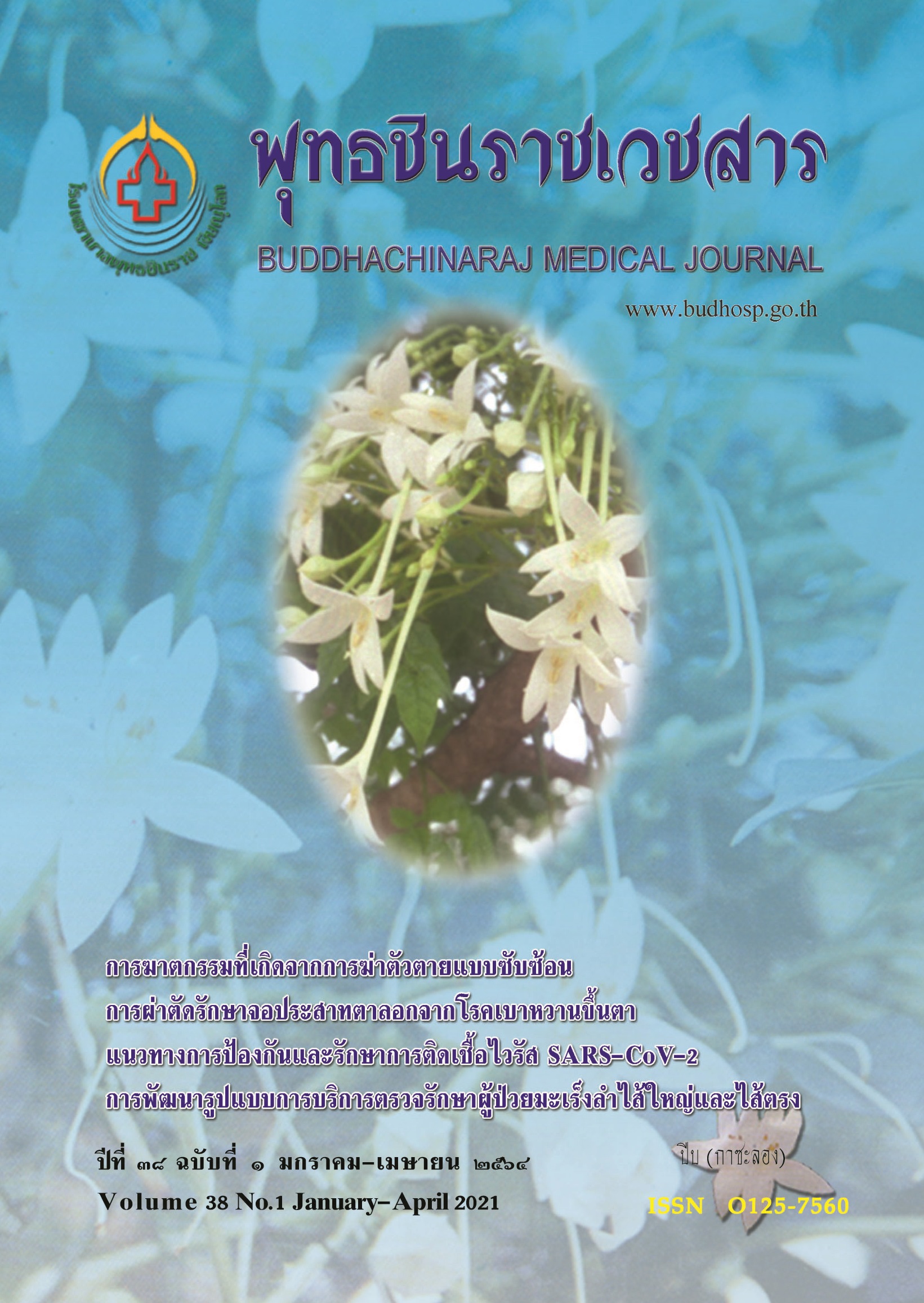ประสิทธิผลระหว่าง 5% โคเคนกับ 10% ลิโดเคนผสม 0.025% อ๊อกซี่เมทาโซลินในผู้ป่วยส่องกล้องโพรงจมูก
ประสิทธิผลระหว่าง 5% โคเคนกับ 10% ลิโดเคนผสม 0.025% อ๊อกซี่เมทาโซลิน
คำสำคัญ:
ยาชาเฉพาะที่, โคเคน, ลิโดเคน, อ๊อกซี่เมทาโซลิน, การส่องกล้องโพรงจมูกบทคัดย่อ
การส่องกล้องตรวจโพรงจมูกมักทำร่วมกับการตรวจทางจมูก การเตรียมผู้ป่วยก่อนส่องกล้องจะให้ยาชาเฉพาะที่และยาลดน้ำมูกเพื่อบรรเทาความรู้สึกไม่สบายและช่วยให้สามารถตรวจเห็นได้ชัดขึ้น การทดลองครั้งนี้มีวัตถุประสงค์เพื่อเปรียบเทียบประสิทธิผลระหว่าง 5% โคเคนกับ 10% ลิโดเคนผสม 0.025% อ๊อกซี่เมทาโซลินในผู้ป่วยส่องกล้องโพรงจมูก โดยสุ่มตัวอย่างไปข้างหน้าและปิดทั้ง 2 ทางในผู้ป่วยที่มีข้อบ่งชี้ในการส่องกล้องโพรงจมูกที่มาตรวจ ณ แผนกผู้ป่วยนอกหู คอ จมูก โรงพยาบาลพุทธชินราช พิษณุโลก จำนวน 66 คน พบว่าระหว่างการใช้ 5% โคเคนกับ 10% ลิโดเคนผสม 0.025% อ๊อกซี่เมทาโซลินนั้นค่ามัธยฐานของความเจ็บปวดในขณะวางยาชา (p = 0.356) ในขณะส่องกล้อง (p = 0.307) และจำนวนตำแหน่งความชัดเจนจากการส่องกล้อง (p= 0.408) ไม่แตกต่างกัน ส่วนภาวะแทรกซ้อนจากการส่องกล้องโพรงจมูกแตกต่างกัน (p = 0.045) แต่จำนวนผู้ป่วยที่พึงพอใจในเลือกใช้ยาครั้งต่อไปไม่แตกต่างกัน (p = 0.325) จึงสรุปได้ว่าประสิทธิผลของ 5% โคเคนนั้นไม่แตกต่างกับ 10% ลิโดเคนผสม 0.025% อ๊อกซี่เมทาโซลินในผู้ป่วยส่องกล้องโพรงจมูก แต่ 10% ลิโดเคนผสม 0.025% อ๊อกซี่เมทาโซลินอาจทำให้ผู้ป่วยมีอาการ แสบร้อนบริเวณที่ทายาชามากกว่า จึงเป็นอีกทางเลือกหนึ่งสำหรับการเตรียมผู้ป่วยก่อนส่องกล้องโพรงจมูก
เอกสารอ้างอิง
2. Kanobthammachai K. Diagnosis "nasopharyngeal cancer" by nasopharyngoscopy [Internet]. [n.d.] [cited 2020 May 6]. Available from: https://www.phyathai.com/article_detail/2370/th/ตรวจหา_"มะเร็งโพรงจมูก"_ด้วยการส่องกล้อง_Nasopharyngoscopy?branch= PYT2
3. Asanasen P. Using a nasal spray in combination with steroid nasal spray for treatment. Clinic 2018;32(10):1016-20.
4. Feyh LS. The chemistry and pharmacology of local anesthetics. CRNA 1993;4(4):161-9. PMID:8260915
5. Nimsomboon T. Cocaine toxicology. Thai J Hosp Pharm 2018;28(3):192-200.
6. Porter MJ, Marais J, Tolley N. Comparison of cocaine alone or with adrenaline on nasal mucosal blood flow. J Laryngol Otol 1991;105(11):918-20. doi: 10.1017/s0022215100117815
7. Tarver CP, Noorily AD, Sakai CS. A comparison of cocaine vs lidocaine with oxymetazoline for use in nasal procedures. Otolaryng Head Neck 1993;109(4):653-9.
8. Latorre F, Otter W, Kleemann PP, Dick W, Jage J. Cocaine or phenylephrine/lignocaine for nasal fibreoptic intubation. Eur J Anaesth [Internet]. 1996 Nov [cited 2021 Apr 7];13(6):577-81. Available from: https://pubmed.ncbi.nlm.nih.gov/8958488/
9. Sessler CN, Vitaliti JC, Cooper KR, Jones JR, Powell KD, Pesko LJ. Comparison of 4% lidocaine/0.5% phenylephrine with 5% cocaine: which dilates the nasal passage better? Anesthesiology 1986;64(2):274-7.
10. Gross JB, Hartigan ML, Schaffer DW. A suitable substitute for 4% cocaine before blind nasotracheal intubation: 3% lidocaine-0.25% phenylephrine nasal spray. Anesth Analg 1984;63(10):915-8. PMID: 6207751
11. Gaviola GC, Chen V, Chia SH. A prospective, randomized, double-blind study comparing the efficacy of topical anesthetics in nasal endoscopy. Laryngoscope [Internet]. 2013 Apr 1 [cited 2020 Apr 27];123(4):852-8. doi.wiley.com/10.1002/lary.23966
12. Cochran WG. Sampling techniques. 3rd ed. New York City, New York state, USA: John Wiley & Sons; 1977.
13. Sirasa R. Chronic pain assessment in the elderly. Ramathibodi Med J [Internet]. 2018 Oct 10 [cited 2021 Apr 10];41(3):92-9. Available from: https://he02.tci-thaijo.org/index.php/ramajournal/article/view/105204
14. Nattarangsi W, Intrarak T. Pain reduction in rigid nasal endoscopy between 1% lidocaine with oxymetazoline and 2% lidocaine with oxymetazoline: a double-blind randomized controlled trial. J Dept Med Serv [Internet]. 2020 Apr [cited 2020 Dec 14];2:91-7. Available from: https://he02.tci-thaijo.org/index.php/JDMS/article/view/245500/166858
15. Wuttiwongsanon C, Teeraboonyakul W. Comparative study between efficacy of 0.025% oxymetazoline with 1% lidocaine and 1% ephedrine with 2% lidocaine in nasal preparation before nasal endoscopy. J Dept Med Serv [Internet]. 2019 Aug 2 [cited 2020Dec 21];44(1):63-6. Available from: https://thaidj.org/index.php/BDMJ/article/view/7277
16. Sirirattanapan J. Comparison of using 2% lidocaine with adrenaline to 10% lidocaine with ephredine in nasal endoscopy. J Sci Technol [Internet]. 2012 [cited 2020 Dec 21];4(7):13-22. Available from: http://ejournals.swu.ac.th/index.php/SWUJournal/article/view/2354
17. Saif AM, Farboud A, Delfosse E, Pope L, Adke M. Assessing the safety and efficacy of drugs used in preparing the nose for diagnostic and therapeutic procedures: a systematic review. Clin Otolaryngol [Internet]. 2016 Feb 11 [cited 2021 Apr 7];
41(5):546-63. Available from: https://pubmed.ncbi.nlm. nih.gov/26452438/
18. Gaviola GC, Chen V, Chia SH. A prospective, randomized, double-blind study comparing the efficacy of topical anesthetics in nasal endoscopy. Laryngoscope [Internet]. 2013 Apr [cited 2021 Apr 16];123(4):852-8. Available from: https://pubmed.ncbi.nlm.nih.gov/23404424/
19. Charoenchasi P, Thanavirattaninit S, Boonnak C. Rhinosinusitis. Bangkok, Thailand: Pentagon Advertising Limited Partnership; 2010.
20. The Royal College of Anesthesiologist of Thailand. Guidance for patient information about anesthesia. Bangkok, Thailand: The Royal College of Anesthesiologist of Thailand; 2019.






